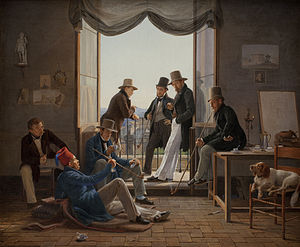Constantin Hansen

from left to right Hansen, Rørbye , Marstrand , Küchler , Blunck and Sonne .
Oil on canvas, 62 × 74 cm, Statens Museum for Kunst , Copenhagen.
Carl Christian Constantin Hansen (born November 3, 1804 in Rome , † March 29, 1880 in Copenhagen ) was a Danish history painter .
Life
Hansen was the son of the painter Hans Hansen (1769–1828). He was born in Rome and was baptized in Vienna the following year ; his family stopped there on their return journey to Denmark. He was a nephew of Constanze Mozart , the widow of the composer Wolfgang Amadeus Mozart , who had married a Danish consul for the second time . In her honor he was given the name Constantin.
From 1817 Hansen began studying architecture at the Copenhagen Art Academy . In 1821 he broke off this course and from then on devoted himself entirely to painting. Hansen became a student in Christoffer Wilhelm Eckersberg's studio and was able to successfully debut four years later with a few portraits at an exhibition at the Academy.
In 1835 Hansen received a two-year scholarship for his achievements , which enabled him to travel to Italy. In the late summer of the same year he traveled to Munich via Berlin , Dresden , Prague and Nuremberg . From there via Salzburg and Florence to Rome . There he soon joined his compatriot, the sculptor Bertel Thorvaldsen and his circle.
From Rome in 1838 Hansen went on a study trip to Naples and Pompeii lasting several weeks with the painter Jørgen Roed . He repeated this the following year with Christen Købke and Georg Christian Hilker and then also visited Paestum . On both trips, Hansen and his friends studied and copied mostly ancient frescoes .
One of his most important paintings from his time in Italy was "A Society of Danish Artists in Rome" from 1837; commissioned by the Copenhagen Art Association . As a portrayal of an unconventional meeting of like-minded people, this picture reflects the new self-confidence of an art-active bourgeois society and has thus become an often cited example.
On his return trip, Hansen stayed in Munich for some time to acquire fresco techniques at the art academy there . This was necessary because of the received government contract. Together with Georg Christian Hilker, he was to decorate the vestibule of the University of Copenhagen , which he did between 1844 and 1853 with themes from Greek mythology . The painter August Andreas Jensdorff was later able to restore the work using Hansen's original cardboard boxes . The art critic Emil Hannover described the work as follows:
"[He created] ... with a clear and deep insight into the essence of ancient painting and Greek mythology, a circle of pictures which, in terms of purity and severity of style, have hardly any equal among the corresponding works from the most recent times."
Between 1861 and 1865 Hansen was entrusted with the decoration of the court theater in Copenhagen; He was supported by Christian Albrecht Jensen . Hansen was also involved in decorating Roskilde Cathedral . In addition, he created several etchings in his late work , with which he mostly thematized vedutas of landscapes and architecture .
On the occasion of his 50th birthday in 1854, Hansen was named titular professor and on his sixtieth birthday he was accepted as a member of the Royal Danish Academy of Art . After the death of Vilhelm Marstrand in 1873, Hansen was entrusted with the management of the academy on his behalf. Around 1878 Hansen resigned all offices and retired into private life. After a brief illness, he died at the age of 75 on March 29, 1880 in Copenhagen. Carl Christian Constantin Hansen was buried on Frederiksberg Ældre Kirkegård of the Frederiksberg Commune on the island of Zealand .
His children include the painter Elisabeth Konstantin-Hansen , the tapestry artist Katharina Hansen and the theologian Sigurd Hansen .
Works (selection)
- The constituent imperial assembly of 1848 (1860/64)
- The Sisters (1826, portrait of his sisters)
- Roman Forum (1837)
- Mrs. Wanscher (1835, portrait)
- Villa Albani garden (1841)
- Birth of Pallas Athena (1850)
- Society of Danish Artists in Rome (1837)
- Dispute between Athena and Poseidon (1851/52)
- Three girls (1827)
- Ariostus reader on the Naples Molo (1840)
- Aegir's Supper (1856)
literature
- Emil Hannover: Painters Constantin Hansen. En study i dansk art history . Kunstforeningen, Copenhagen 1901 ( archive.org ).
- Sigurd Müller : Nyere dansk malerkunst et billedvaerk . Stochholms Forlag, Copenhagen 1884.
- Philip Weilbach : Hansen, Carl Christian Constantin . In: Carl Frederik Bricka (Ed.): Dansk biografisk Lexikon. Tillige omfattende Norge for Tidsrummet 1537-1814. 1st edition. tape 6 : Gerson-H. Hansen . Gyldendalske Boghandels Forlag, Copenhagen 1892, p. 585-590 (Danish, runeberg.org ).
Web links
Individual evidence
- ^ The grave of Carl Christian Constantin Hansen. knerger.de
| personal data | |
|---|---|
| SURNAME | Hansen, Constantin |
| ALTERNATIVE NAMES | Hansen, Carl Christian Constantin (full name) |
| BRIEF DESCRIPTION | Danish history painter |
| DATE OF BIRTH | November 3, 1804 |
| PLACE OF BIRTH | Rome |
| DATE OF DEATH | March 29, 1880 |
| Place of death | Copenhagen |